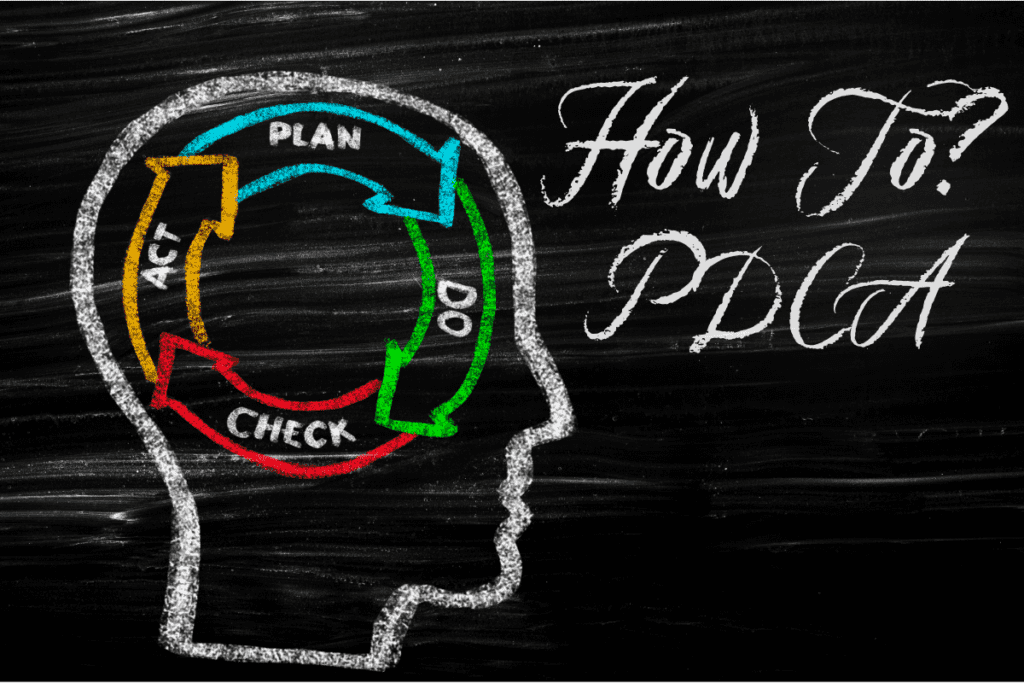Plan-Do-Check-Act Defined – How to Use the PDCA Cycle
By understanding and utilizing the PDCA cycle, organizations and individuals can make incremental changes to continually improve processes and achieve better outcomes. It is a powerful tool for problem-solving, quality control, and driving organizational success. This article will provide transparency into how to use the PDCA Cycle.
Article Key Takeaways
In this article, we will discuss the power of the PDCA Cycle (Plan-Do-Check-Act) and how it can drive continuous improvement and better outcomes for organizations and individuals alike.
- The PDCA Cycle: The PDCA cycle stands for Plan-Do-Check-Act and is a systematic approach to process improvement. It consists of four key steps: Plan, Do, Check, and Act. The PDCA cycle is an iterative process to drive continuous improvement.
- History of PDCA: The PDCA cycle was first introduced by Walter Shewhart and later popularized by Edwards Deming. It became a fundamental concept in various quality management systems, contributing to its widespread adoption.
- Benefits of PDCA: Implementing the PDCA cycle promotes proactive problem-solving and decision-making, leading to effective solutions and reduced risk of failure. It also aligns well with the concept of continuous improvement (Kaizen) and allows for flexibility and adaptability.
- PDCA Process: The four steps of the PDCA cycle involve planning objectives, executing the plan on a small scale, analyzing the results, and making adjustments for continuous improvement.
- Applying PDCA: PDCA is widely used in various areas, such as process improvement and project management. It shares similarities with the scientific method and can be integrated with other methodologies like A3, Kaizen, and Lean Manufacturing for even greater improvements.
What is the PDCA Cycle?
The PDCA cycle stands for Plan-Do-Check-Act, representing the four steps of the cycle. It is a systematic approach to process improvement, where each step is essential for achieving optimum results. The PDCA cycle is a simple and effective model that consists of four key steps: Plan, Do, Check, and Act.
These steps are repeated in an iterative process to drive continuous improvement. It emphasizes the importance of setting clear goals and objectives, planning activities and resources, executing the plan, evaluating the results, and making incremental changes for continuous improvement.
The PDCA (Plan-Do-Check-Act) Cycle is a systematic method used to improve processes and achieve continuous improvement in organizations. This cycle has gained popularity in various industries due to its simplicity and effectiveness.
The PDCA cycle consists of four interrelated stages: Plan, Do, Check, and Act. In the planning stage, goals and objectives are set, and a detailed plan is developed. The next stage involves executing the plan and implementing the necessary changes. After completion, the check stage involves analyzing and evaluating the results.
Finally, the act stage involves learning from the outcomes and making improvements for the next cycle. Understanding and utilizing the PDCA cycle can lead to enhanced productivity, quality, and overall organizational performance.
History of PDCA – Deming and Shewhart’s Contribution
The PDCA cycle, also known as the Deming wheel or the Shewhart cycle, has a rich history. It was first introduced by Walter Shewhart, an American physicist, engineer, and statistician. Shewhart developed the cycle as a way to improve processes and achieve better results. Deming expanded on Shewhart’s work, leading to the PDCA cycle we know today.
Walter Shewhart is often considered the father of statistical quality control. In the 1920s, he was working at Bell Telephone Laboratories and was faced with the challenge of improving the reliability of telegraph transmissions. Shewhart realized that if he could identify and control the sources of variation in the process, he could achieve better outcomes.
It was Edwards Deming, a statistician and management consultant, who popularized plan-do-check-act and made it a cornerstone of his quality management philosophy. Deming is often credited with bringing the concept of continuous improvement to Japan after World War II. In the 1950s,
Deming taught a series of lectures in Japan, where he emphasized the importance of using statistical methods to improve processes and reduce variation. He incorporated Shewhart’s concepts and his own ideas into a simple four-step cycle that became known as the Deming cycle or PDCA cycle.
In the 1980s, American businesses started to take notice of Deming’s ideas, and the PDCA cycle gained popularity as a management tool in the United States and other parts of the world. It has since become a fundamental concept in various quality management systems, such as ISO 9001.
Today, the PDCA cycle is widely used in organizations across industries and sectors. It serves as a systematic approach to problem-solving and continuous improvement, helping organizations identify and address issues, test potential solutions, and learn from their actions.
Benefits of Using the PDCA Model: Why is Plan-Do-Check-Act Important?
Continuous Improvement with PDCA
The PDCA cycle is essential for achieving continuous improvement. By following the cycle, organizations can identify areas for improvement, implement changes, and monitor the results. This iterative process allows for ongoing enhancements and ensures that organizations stay ahead of their competition.
Benefits of Using the PDCA Cycle
There are several benefits to using the PDCA cycle. First, it promotes a proactive approach to problem-solving and decision-making. It encourages organizations to plan and test their ideas before implementing them on a larger scale. This reduces the risk of failure and ensures that the implemented solutions are effective.
There are several benefits to using the PDCA cycle. First, it promotes a proactive approach to problem-solving and decision-making. It encourages organizations to plan and test their ideas before implementing them on a larger scale. This reduces the risk of failure and ensures that the implemented solutions are effective.
Kaizen and PDCA
Kaizen, a Japanese term meaning “change for the better,” is closely related to the PDCA cycle. It emphasizes the concept of continuous improvement and encourages small, incremental changes over time. The PDCA cycle provides a framework for implementing kaizen principles in a structured manner.
Benefits of the Iterative Process in PDCA
The iterative nature of the PDCA cycle offers several benefits. It allows for flexibility and adaptability, as organizations can make adjustments based on the information gathered during each iteration. This leads to faster problem-solving and ensures that organizations are continuously learning and improving.
PDCA Process: How Do The Steps of the PDCA Cycle Work?
The PDCA cycle consists of four steps: Plan, Do, Check, and Act. The steps are outlined below:
1. Plan Phase
In the first phase, Plan, organizations define their objectives and develop a detailed plan to achieve them. This includes identifying the problem or opportunity, setting goals, and determining the actions needed to accomplish those goals.
2. Do Phase
The Do phase involves implementing the plan on a small scale. Organizations take action based on the plan and collect data or feedback to evaluate the results. This phase provides valuable insights and helps identify any discrepancies between the expected and actual outcomes.
3. Check Phase
Collecting and analyzing data to assess the effectiveness of the implemented changes happens in the Check phase. Also during this phase organizations determine if the actions taken has led to the desired results and whether any further adjustments are necessary.
4. Act Phase
This final step is based on the data and feedback collected in the previous phases, Any Necessary adjustments and improvements to the plan are made and then implemented on a larger scale.
This phase ensures that the changes made are sustainable and continuous improvement is achieved. The cycle then starts again with the Plan phase, allowing organizations to continuously improve and refine their processes.

How to Continuously Improve: Applying the PDCA Cycle to Problem-Solving
Using PDCA for Process Improvement
The PDCA cycle is widely used for process improvement initiatives. By following the iterative process, organizations can identify bottlenecks, inefficiencies, or areas of waste in their processes. They can then implement changes and measure the impact of these changes using the Check and Act phases of the PDCA cycle.
PDCA in Project Management
The PDCA cycle is also applicable to project management. By breaking down projects into smaller steps and regularly evaluating and adjusting the plan, project managers can ensure that the project stays on track and meets the desired outcomes.
The PDCA Cycle and the Scientific Method
The PDCA cycle shares many similarities with the scientific method. Both involve making hypotheses, testing them through experiments or implementations, and analyzing the results to draw conclusions. This connection emphasizes the importance of data-driven decision-making in the PDCA cycle.
PDCA Cycle vs. Six Sigma: A Comparison
Now, you might be wondering how the PDCA cycle compares to Six Sigma. While they both aim for continuous improvement, they approach it in slightly different ways. Six Sigma is more data-driven and focuses on reducing variability, while the PDCA cycle is more about iterative problem-solving and process improvement.
Integrating PDCA with Other Methodologies: A3, Kaizen, and More
The PDCA cycle plays well with others, too! It can be integrated with other methodologies like A3, Kaizen, and Lean Manufacturing to drive even greater improvements.
- A3 is a structured problem-solving methodology that uses visual management tools to identify root causes, create plans, and implement countermeasures. PDCA within A3 tests and improves the effectiveness of countermeasures.
- Kaizen method is a continuous improvement approach empowering employees to make small incremental changes. PDCA within Kaizen plans, tests, and adjusts improvements.
- Lean Manufacturing aims to create customer value by eliminating waste and improving efficiency. PDCA within Lean continuously identifies and eliminates waste, while monitoring and improving key performance indicators.
Integrating the PDCA cycle with these methodologies can enhance problem-solving and continuous improvement efforts by providing a structured approach to plan, test, adjust, and monitor changes. It helps ensure that improvements are implemented effectively and that results are continuously evaluated and refined.
By combining the strengths of each methodology, organizations can drive even greater improvements and achieve better results.
Conclusion
In summary, the PDCA cycle, also known as the Deming wheel or the Shewhart cycle, is an iterative process that helps individuals and organizations improve their processes. By following the steps of plan-do-check-act model, you can make small-scale changes and continually monitor and adjust to achieve better results.
Whether you are implementing it for project management, process improvement, or problem-solving, the PDCA cycle is a valuable tool in achieving your goals.
If you liked this article, remember to subscribe to MiamiCloud.com. Connect. Learn. Innovate.







